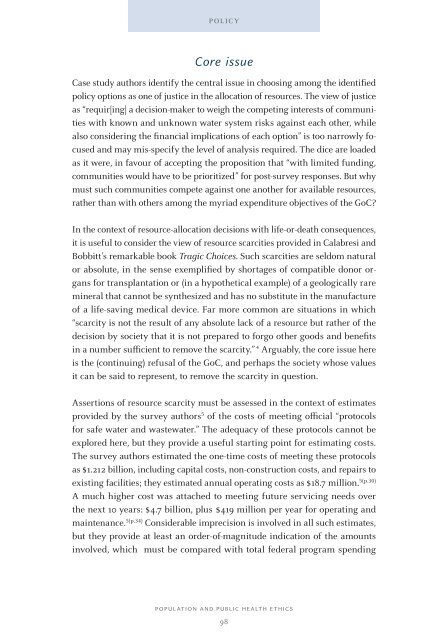PoPulationand Public HealtH etHics
PoPulationand Public HealtH etHics
PoPulationand Public HealtH etHics
You also want an ePaper? Increase the reach of your titles
YUMPU automatically turns print PDFs into web optimized ePapers that Google loves.
policy<br />
Core issue<br />
Case study authors identify the central issue in choosing among the identified<br />
policy options as one of justice in the allocation of resources. The view of justice<br />
as “requir[ing] a decision-maker to weigh the competing interests of communities<br />
with known and unknown water system risks against each other, while<br />
also considering the financial implications of each option” is too narrowly focused<br />
and may mis-specify the level of analysis required. The dice are loaded<br />
as it were, in favour of accepting the proposition that “with limited funding,<br />
communities would have to be prioritized” for post-survey responses. But why<br />
must such communities compete against one another for available resources,<br />
rather than with others among the myriad expenditure objectives of the GoC?<br />
In the context of resource-allocation decisions with life-or-death consequences,<br />
it is useful to consider the view of resource scarcities provided in Calabresi and<br />
Bobbitt’s remarkable book Tragic Choices. Such scarcities are seldom natural<br />
or absolute, in the sense exemplified by shortages of compatible donor organs<br />
for transplantation or (in a hypothetical example) of a geologically rare<br />
mineral that cannot be synthesized and has no substitute in the manufacture<br />
of a life-saving medical device. Far more common are situations in which<br />
“scarcity is not the result of any absolute lack of a resource but rather of the<br />
decision by society that it is not prepared to forgo other goods and benefits<br />
in a number sufficient to remove the scarcity.” 4 Arguably, the core issue here<br />
is the (continuing) refusal of the GoC, and perhaps the society whose values<br />
it can be said to represent, to remove the scarcity in question.<br />
Assertions of resource scarcity must be assessed in the context of estimates<br />
provided by the survey authors 5 of the costs of meeting official “protocols<br />
for safe water and wastewater.” The adequacy of these protocols cannot be<br />
explored here, but they provide a useful starting point for estimating costs.<br />
The survey authors estimated the one-time costs of meeting these protocols<br />
as $1.212 billion, including capital costs, non-construction costs, and repairs to<br />
existing facilities; they estimated annual operating costs as $18.7 million. 5(p.30)<br />
A much higher cost was attached to meeting future servicing needs over<br />
the next 10 years: $4.7 billion, plus $419 million per year for operating and<br />
maintenance. 5(p.34) Considerable imprecision is involved in all such estimates,<br />
but they provide at least an order-of-magnitude indication of the amounts<br />
involved, which must be compared with total federal program spending<br />
PoPulation anD <strong>Public</strong> <strong>HealtH</strong> <strong>etHics</strong><br />
98
















